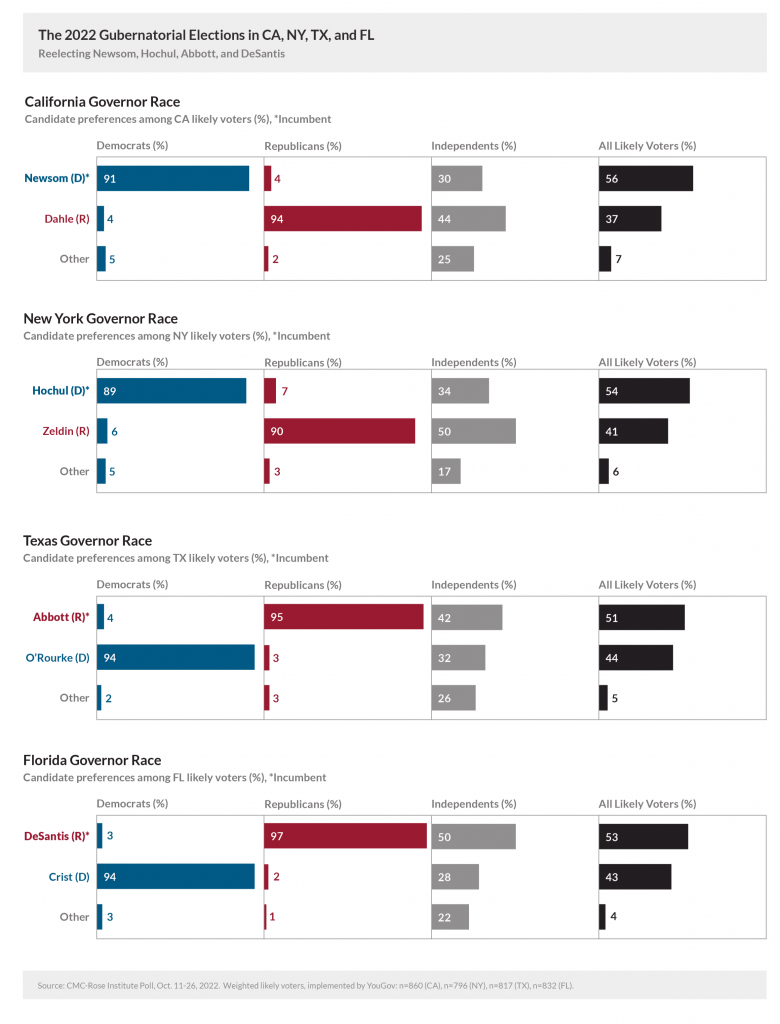Released on November 4, 2022 (Updated November 8)*
by J. Andrew Sinclair, Ph.D. & Kenneth P. Miller, J.D., Ph.D.
Download PDF

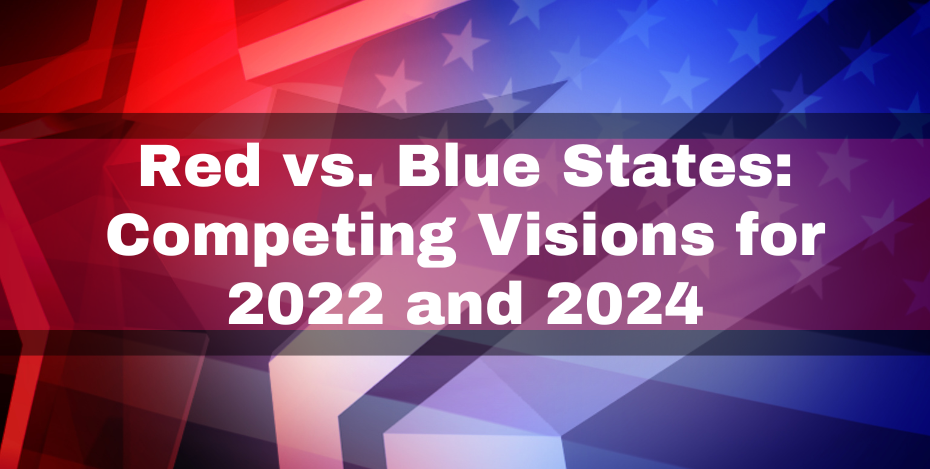
Competing Visions in the Nation’s Largest States
The governors of the nation’s four largest states, California, Texas, Florida, and New York, face voters in 2022. Beyond determining who will occupy governors’ offices, these contests will shape our nation’s direction in the coming years. The four “mega-states” have established rival and increasingly polarized visions of state government–one blue, the other red. California and New York have become national catalysts for progressive policies, while Texas and Florida have become the most powerful advocates of conservative alternatives. Their governors–Gavin Newsom (D-CA), Kathy Hochul (D-NY), Greg Abbott (R-TX), and Ron DeSantis (R-FL)–have come to embody these states’ highly partisan models. This election thus provides voters in the four states an opportunity to judge not only their governors, but also the blue or red agendas they represent. Moreover, the elections may give momentum to at least two of these governors–Newsom and DeSantis–to sell their states’ competing visions to the nation by running for president in 2024.
Using new survey data, this report highlights four main findings.
- The governors of all four states have positioned themselves to win reelection in 2022 by retaining the support of members of their state’s dominant party, rendering opposition by people outside that party largely irrelevant.[1]
- The four governors are on track to win reelection even though a large share of their constituents are dissatisfied with recent economic and social trends.
- Many residents of these states are considering moving elsewhere, most frequently those (such as Republicans in California and New York) who disagree with their state’s dominant political orientation. Many are interested in moving to a place where their neighbors would have political and policy preferences closer to their own.
- After their expected reelections, at least two of these governors–DeSantis and Newsom–are positioned to carry their states’ policy visions into a national competition for the presidency.
The 2022 Election
How are these governors and their policy agendas faring in the 2022 elections? As a consequence of the nation’s deep polarization and geographic partisan sorting, the governors of all four states, and the policies they advance, are safe.[2] Despite their vastly different approaches to the pandemic, economic challenges, and cultural conflict, all of these governors will almost certainly achieve the same result: reelection.
The path all four governors are taking to reelection is paved with partisanship. For all the stresses of the last four years, the vast majority of voters in each state who identify with the incumbent’s party are going to remain loyal to the incumbent. Among likely voters: in California, 91% of Democrats are for Newsom; in New York, 89% of Democrats are for Hochul; in Texas, 95% of Republicans are for Abbott; and, in Florida, 97% of Republicans are for DeSantis.
What about the voters from the other party? At least 90% of voters from the opposing party in each state are sticking with their party’s candidate. Meanwhile, independent voters are not moving the needle. In Texas and Florida, independents are marginally adding to the incumbent’s lead, whereas in California and New York, disapproval from independents is not enough to overcome the Democrats’ large numerical advantages.
Assessing the States
One might think incumbents in these states should fear voter retribution at a time when many Americans are struggling. Holding incumbents accountable is complicated, though, in a system where policy authority is divided across multiple layers and branches of government, and partisanship seems to be more important than actually evaluating a governor’s performance.
In each of the four states, our survey explored voter perceptions about how life was going with respect to “your personal financial situation” and “the quality of life in your community.” We asked: “For each area, are things better or worse than they were two years ago?”
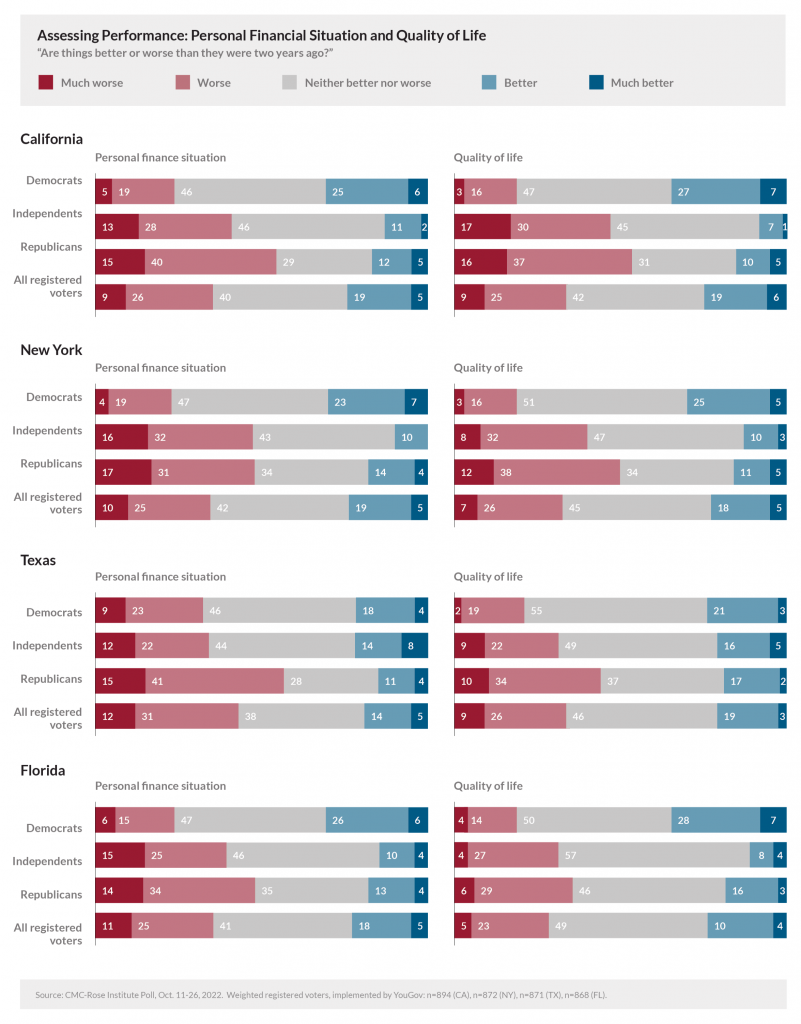
Financial well-being
Leading up to the 2022 midterms, much economic news has been troubling, especially regarding inflation. In this environment, it should not be surprising that large numbers of respondents in all four states (about one-third in CA, NY, and FL; nearly one-half in TX) described themselves as worse or much worse off financially than they were two years ago. Conversely, in each state, no more than 5% overall said they were financially “much better” off.
Yet, concerns about personal finances do not appear to be driving voting decisions in the gubernatorial races in these states. Nearly one-fourth of Democratic voters (24% in California and 23% in New York) described themselves as worse off or much worse off now than they were two years ago, yet about 9 of 10 Democrats in those states will vote for Governors Newsom and Hochul. Similarly, 56% of Republicans in Texas and 48% of Republicans in Florida report that they are worse off or much worse off now than two years ago, yet nearly all Republicans in those states will line up to reelect Governors Abbott and DeSantis.
Quality of life
This strain of pessimism extends to “quality of life in your community.” Approximately one-third of all respondents in the four states stated that the quality of life in their community was worse or much worse now than two years ago. The responses varied by party, with greater percentages of Republicans than Democrats in both red and blue states expressing this view. Yet, many Democrats also shared this concern. In both California and New York, 1-in-5 Democratic registered voters stated that the quality of life has worsened at a time when most of their state and federal representatives are Democrats. Moreover, some Democrats reported a worsening financial situation and others a worsening quality of life; in California, for example, 1-in-3 Democrats thought that the quality of life was worse or that their personal financial situation was worse.
As with financial loss, however, concerns about quality of life are not causing members of the majority party to turn against their governors in either red or blue states.
Exit
Nevertheless, unrest can express itself in other ways–including thoughts of moving out of state. People have many reasons for migrating from one state to another, including educational or job opportunities, comparative cost of living, or family connections. Increasingly, Americans are also choosing to move to places that align with their political views. Population exit has become a prominent issue in blue states, including California and New York, which for years have experienced negative net migration.
Our survey asked respondents to describe their interest in moving as follows: “Regardless of whether you will move, if you had the opportunity, would you like to move to another state, or would you rather remain in your current state?” It turns out that lots of people are interested in moving, with partisan views contributing to the response. Specifically, Republicans are more likely to want to leave California and New York and more Democrats are more likely to want to leave Texas and Florida.
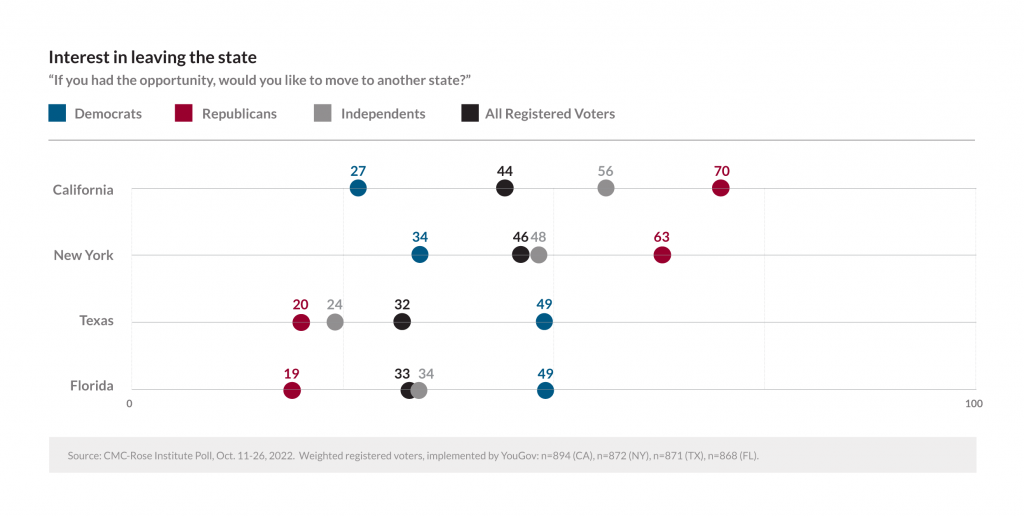
In California, a remarkable 70% of Republicans said they are interested in leaving the state, compared to 27% of Democrats. The gap was smaller but still large in New York, with 63% of Republicans expressing an interest in moving, compared with 34% of Democrats. Meanwhile, nearly half of Democrats in Florida and Texas expressed an interest in moving out of state, more than twice the number of Republicans who want to do so.
Reasons for Moving
For all respondents who expressed an interest in moving, we asked a simple follow-up question: why? We then provided a free response box. Assisted by student research assistants at the Rose Institute of State and Local Government, we divided responses into three categories: economic reasons, political and policy reasons, and personal reasons.
In California, many respondents from across the political spectrum described concerns about the cost of living and other aspects of the economy. Meanwhile, many Republicans described concerns about politics and policy, while very few Democrats did. A Republican from San Diego wrote, “Taxes are too high in my state and the quality of life is getting worse.” An independent from near Santa Barbara wrote more simply, “CA is run by morons.”
The story is somewhat different in Texas and Florida. Fewer residents of these states want to leave at all, and very few want to move for economic reasons. More of the potential movers are motivated by what we categorized as personal reasons. One Florida resident wrote: “Hurricanes and heat plus critters.” Another: “too hot.” Democrats in Texas and Florida had additional reasons, frequently mentioning politics and policy concerns. “DeSantis,” wrote one Democratic respondent, “is crazy.”
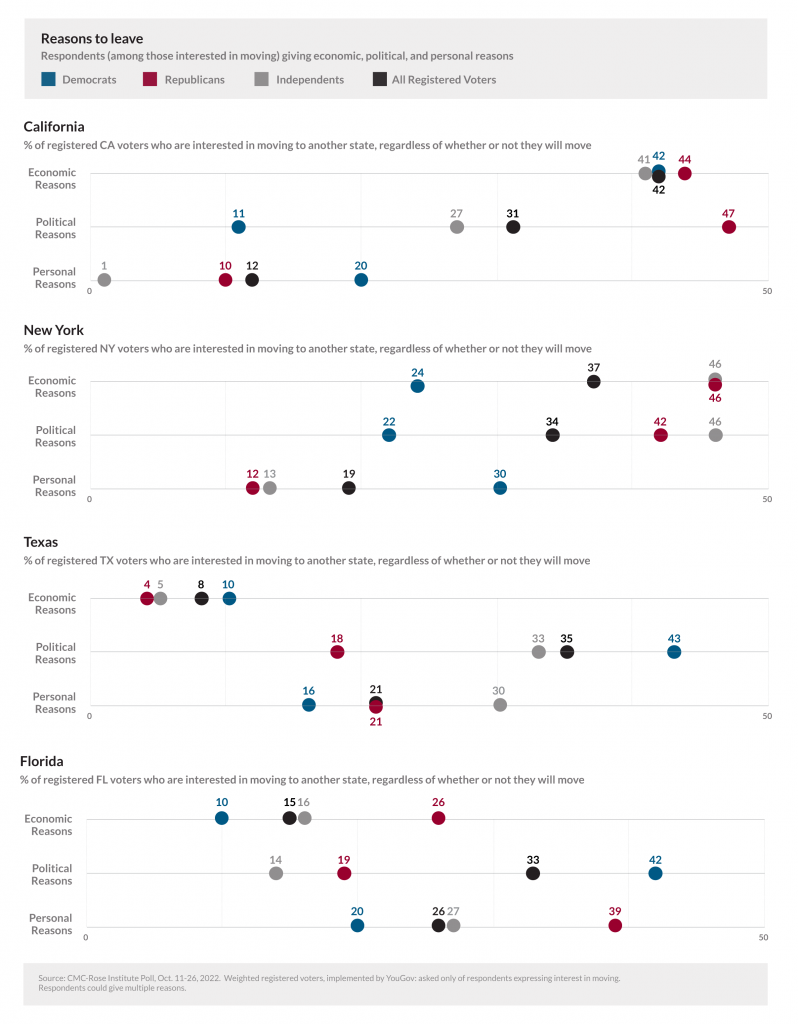
Steps Toward Leaving
Our initial question was framed as interest in leaving, without necessarily having it be a real option. Yet, some respondents may be taking more concrete steps toward actually leaving. A process to move could involve discussing it with family members, finding a new place to live, searching for a new job, and learning about features of a new place like schools.
The most common activity was discussing leaving with family, followed by searching for a place to live. Only about a fifth searched for a new job; further, not very many at all learned about new schools. To the extent that planning to move may require at least three of those steps, not very many respondents are close to moving. In California, for all its dissatisfied people, only 2% had taken all four actions.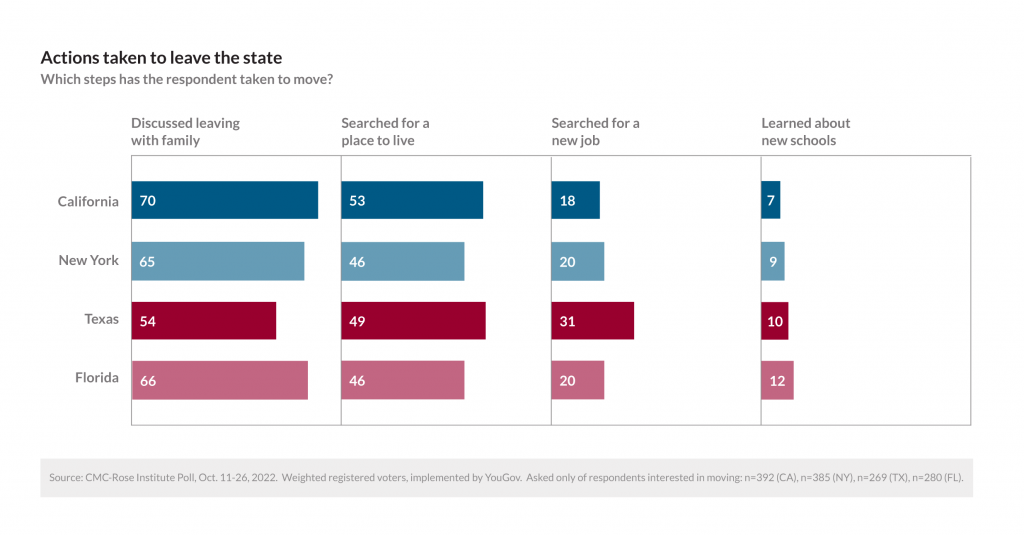
Where to?
Many respondents might imagine moving to someplace renowned for its natural environment, such as Hawaii or Colorado. Others might be thinking of moving to adjacent states for jobs or family. We wanted to focus on the states in our survey, so we asked where the respondents would “most like to live” if they “had to choose only among these states.” The states were: California, New York, Texas, Florida, and Pennsylvania.
Limiting the moving choice has an obvious consequence: some of those nominally interested in leaving are not interested in leaving for any of these places, so they select their home state.
Among Democrats, California appears to be a bit more attractive than New York, and there is some interest in the red states as well. The picture is a bit clearer for the Republicans. In California, 86% of the Republicans interested in exiting want to move to Texas or Florida.
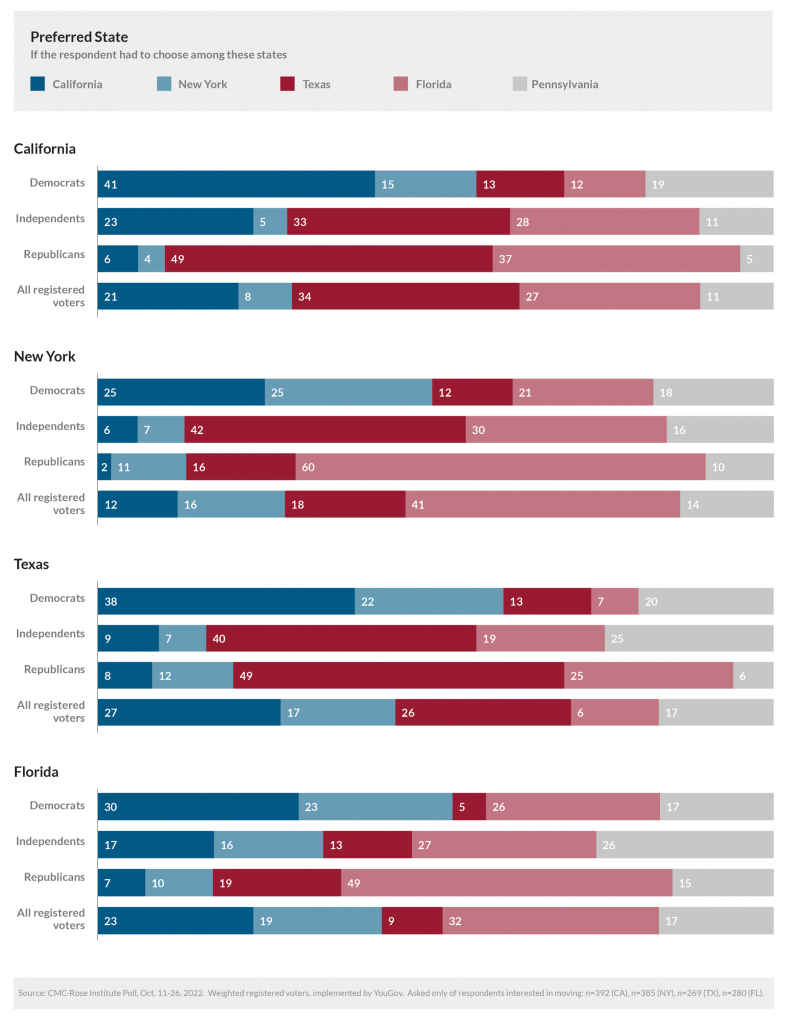
Going National
The nation’s political future is uncertain, as partisans on both sides are waiting to see whether the presidential nominees in 2020 will run again in 2024. In the meantime, a new generation of potential presidential contenders is taking shape. Of the four governors discussed in this report, DeSantis and Newsom are best positioned to run, although Newsom has disavowed any plans to do so. If Newsom or DeSantis make bids, it is clear they would use their respective states as models for what the nation as a whole should become. Newsom and DeSantis have already been sparring by attacking the rival state’s policies. (Newsom has also engaged in verbal battles with Texas governor Greg Abbott, another potential presidential candidate.)
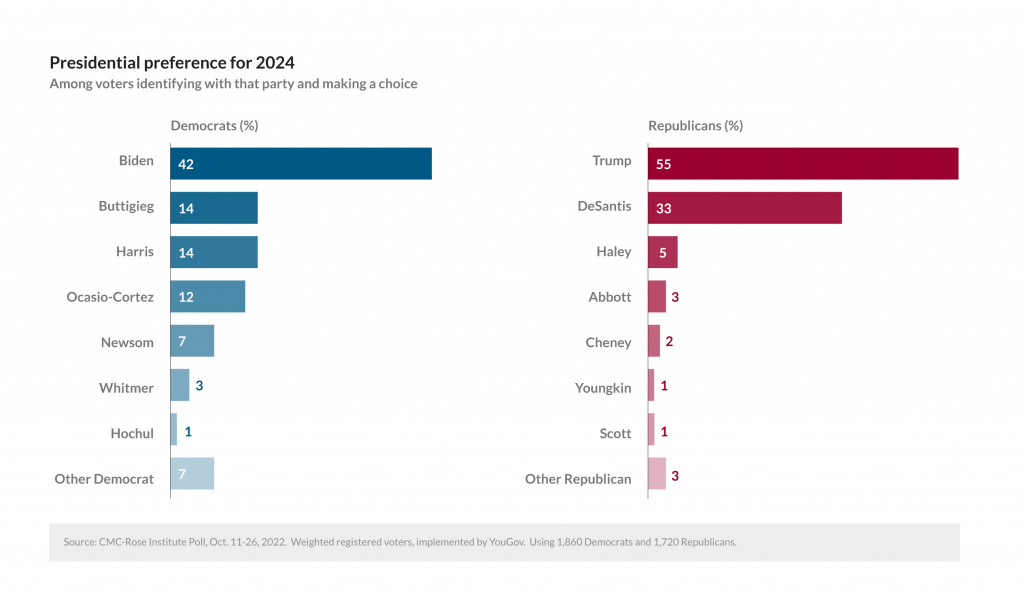
Our survey asked respondents across the nation to register their early preferences for the 2024 presidential race. Our results are broadly consistent with the findings of other publicly available polls: among Democratic candidates, President Biden is ahead, but there is no clear back-up option. Among Republicans, former President Trump is the most popular, with Florida Governor Ron DeSantis clearly the leading alternative. On the presidential preference question including both Biden and Trump, we asked all respondents to choose from a field that included both Republican and Democratic potential candidates. However, we present in this graph only the preferences of respondents who belong to the candidate’s party, and omit the responses of independents and anyone who expressed a cross-party preference.[3]
This survey differs from others by including in the field Governor Hochul of New York and Governor Abbott of Texas–as well as California’s Governor Newsom, whom most early polls have excluded. At this early stage, all such choices are speculative. In any event, our purpose is not predictive. Instead, the poll seeks to highlight the levels of early support for Newsom compared to Hochul and DeSantis compared to Abbott, and to explore how DeSantis is faring as a potential successor (or challenger) to Trump.
Among Democrats, Newsom (7%) lags behind Vice President (and fellow Californian) Kamala Harris (14%) in the large field that includes Biden, and it is far from clear he would be willing to challenge either Harris or Biden. As a follow-up, we asked Democrats to choose head-to-head between Harris and Newsom.[4] In that match-up, Harris leads Newsom 56-44%.
We also asked Republican respondents to choose head-to-head between DeSantis and Trump. In that match-up, Trump leads DeSantis, 55-45%–a slimmer margin than when they were part of a larger field.
While interesting for a variety of reasons, match-ups including Biden or Trump do not cause respondents to consider the possibility of a governor introducing a blue or red state model to the nation as a whole.

Instead, we asked all respondents across the nation to choose, head-to-head, between Newsom and DeSantis. The results highlight just how closely the country is split when selecting between governors who have developed two radically different state-level policy visions. In this match-up, DeSantis barely edges out Newsom, 51-49%. Our findings indicate that both candidates can count on the support of vast majorities of their own parties, with Newsom losing slightly more Democrats than DeSantis loses Republicans. Independents are closely divided between the two.
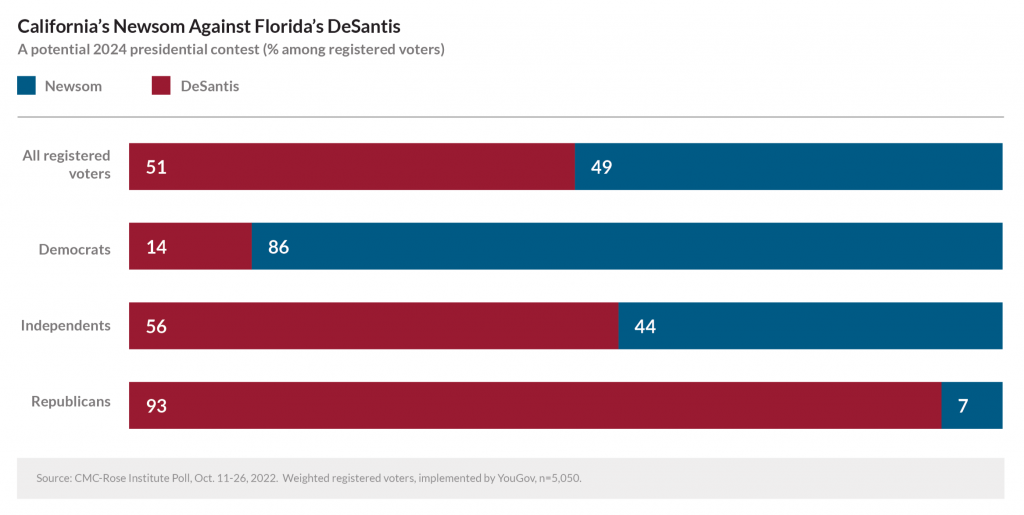
Conclusion
This survey provides fresh evidence that the nation’s four most populous states remain firmly located on opposite sides of our partisan divide, with two in the red camp and two in the blue. As functionally one-party polities, these states can pursue aggressive policy agendas, but they also risk overreaching and alienating residents who don’t subscribe to their dominant political values. One-party hegemony in these states also allows their governors to build robust policy records they can wield when stepping onto the national stage. The conflict between the blue and red states and their representatives has been building for some time, and may reach a climax in our not-too-distant political future.
The Survey
The data for this survey comes from the CMC-Rose Institute Fall 2022 Poll. This survey, implemented online by YouGov between October 11 and 26, 2022, included 5,060 respondents. The survey design included a national sample of 1,000 registered voters and state oversamples of approximately equal sizes of registered voters in California, New York, Texas, and Florida, as well as in Pennsylvania (the subject of a separate report). YouGov also provided survey weights that permitted the analysis of the national sample of registered voters, a subset identified as likely voters, and the same quantities in each state. The margin of error in the national sample is ±3; for each of the four states examined extensively in this report, it is ±4.
Throughout this report, we discuss voters as “Republicans,” “Independents,” and “Democrats.” We have relied on standard questions about “party identification” to describe these voters and have combined some categories together. For example, Republicans include strong Republicans, not so strong (“weak”) Republicans, and independents who lean toward the Republican Party. Democrats are defined similarly.[5] Independents are voters who have no party lean, those preferring some other party, and those “not sure.”
These results are part of a larger survey project conducted by the CMC-Rose Institute Poll during the 2022 election cycle. More results can be found at www.roseinstitute.org.
Founded in 1973 at Claremont McKenna College, the Rose Institute is one of the nation’s leading academic centers focused on the study of state and local government. For more information, visit www.roseinstitute.org.
*Note: This report was updated on November 8, 2022 to correct an insignificant typographical error.
Media contacts:
Andrew Sinclair, Ph.D.
Director of Polling, Rose Institute of State and Local Government
Assistant Professor of Government
Claremont McKenna College
andrew.sinclair@claremontmckenna.edu
(626) 376-1105
Kenneth P. Miller, J.D., Ph.D.
Director, Rose Institute of State and Local Government
Rose Professor of State and Local Government
Claremont McKenna College
kmiller@cmc.edu

